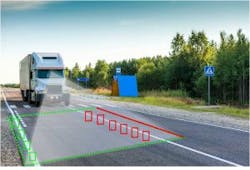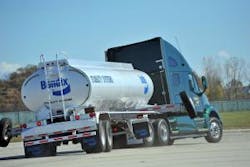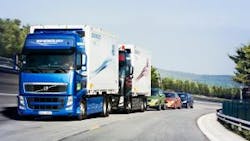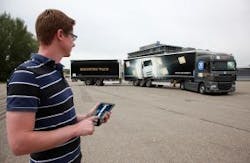Is the self-driving truck this century’s flying car, or is it a true technological breakthrough that will transform the lives of drivers and the operations of fleets that employ them?
Tough question, and the answer depends on who you ask. Lawyers and legislators will certainly have a say in the future of self-driving trucks and other vehicles on our roadways. And some thorny issues around drivers themselves will also need to be addressed if we’re ever going to realize the promise. But when it comes to the technology, we pretty much have the answer already.
Before we get to that answer, though, we need some definition. As with most complex new technologies, there’s confusion over what’s actually meant by a self-driving truck, or what is more correctly called an autonomous truck by the engineering community.
What we’re really talking about is a group of technologies that can be combined in a variety of ways to create levels of automation that relieve a driver of different responsibilities under a wide range of circumstances.
The National Highway Traffic Safety Administration (NHTSA) formally divides vehicle automation into five levels. NHTSA’s Level 0 is no automation at all, with the auto or truck driver in complete and sole control of the vehicle at all times. Level 1 adds automation for specific control functions, with technologies such as electronic stability control or ABS. Level 2 extends that by combining two or more of those systems to take over control from the driver in specific situations. NHTSA’s example of a Level 2 vehicle is one where adaptive cruise control is combined with a lane sensing system to keep it centered in its lane and traveling at the same speed as the vehicle in front of it.
The next level
What most of us would think of as a self-driving truck is classified as Level 3 by NHTSA, or what it calls “limited self-driving automation.” At Level 3 a driver could turn over full control of the vehicle under the right conditions for long periods of time. The vehicle monitors conditions around it and when necessary turns control back to the driver, who is always available to take control. Trucks that could drive themselves on highways either alone or in a platoon would be considered Level 3 vehicles.
A fully autonomous or Level 4 vehicle would be able to initiate and complete an entire trip without any driver input beyond entering navigation waypoints or a destination. Once directed to a destination, the Level 4 truck could even operate without anyone aboard.
From this perspective, the self-driving truck isn’t that always-in-the-future flying car, at least not at Level 3. In fact, most of the foundation technologies are already available in production trucks, or will be within the year. And the final pieces needed to create the Level 3 autonomous truck are already well along in the development stage.
“What I see is evolution, not revolution,” says Alan Korn, director of advanced brake system integration for Meritor Wabco. Early stages in that evolution could be considered the introduction of active safety systems like stability control and ABS, technologies that make control decisions solely on vehicle conditions. The first truly “big stepping stone” in the evolution of a self-driving truck was the introduction of heavy-truck collision mitigation systems like Meritor Wabco’s OnGuard and Bendix’s Wingman “because they make control decisions based on both the vehicle and the environment,” says Korn. “Taking control [of the truck] based on what’s outside the truck was, for me, a very large step technology-wise.”
Working together
The next steps in Korn’s evolutionary vision involve integration. First, in the very near future, discrete technologies like lane departure warning, smart cruise control and blind-spot detection will be integrated to give the driver 360 deg. vision of the entire tractor and trailer. That will help the driver reduce accidents but still leave them in full control of the vehicle. Fusing all that data with powerful processors and software would then allow automation of common control decisions, taking yet another major step toward the Level 3 self-driving truck, he believes.
With such data fusion in place, technology can begin to develop trucks that can drive themselves for periods of time. According to Korn, the key is that such technology would have to outperform a human driver in terms of safety. Truck fatality numbers have dropped to below 1.5 for every million miles traveled, he points out. “Subtract the numbers that were not the truck driver’s fault, which would be the majority, and the technology would have to better that number before we could move to autonomous,” he says. “That’s quite a challenge.”
Fusion of vision technologies is also seen by T.J. Thomas as the next key step in development of the self-driving truck. Thomas, director of marketing and customer solutions for the Control Group at Bendix Commercial Vehicle Systems, explains that the radar used in smart cruise control and blind-spot warning systems identifies the speed and distance of moving objects well, while the cameras used for lane detection can identify the things they see but aren’t ideal for judging relative speed. Using processors to fuse those two data streams is critical to making the reliable control decisions needed for even limited autonomous operation.
Add in high-speed information from other vehicles on the road and perhaps the road infrastructure itself, and you face “what is probably the biggest challenge in terms of decision making for an autonomous vehicle—being able to gather and meld all that data,” says Jim Szudy, engineering manager for vehicle systems at Bendix. Since trucks carry systems from a variety of suppliers, there need to be standards and protocols for coordinating that information.
“Making a left turn is easy, but what if there’s an emergency vehicle coming down the road, and the truck needs to make a decision?” Szudy says. “Some way to process all that data and use it to make the right decisions all the time is one of the biggest things still to be developed.”
Ready and waiting
While development work on information processing is still in the early stages, the systems needed to actually control a truck’s movements without driver input are already largely in production or will be within the next year or so.
Roughly 75% of the technology needed to produce a Level 3 self-driving truck “is already in place,” according to Dennis Mooney, group vice president of global product development at Navistar. Like others involved in autonomous truck projects, he identifies the fusion of camera and radar information as the next step.
“We’re already seeing it on some luxury cars,” Mooney says. “It lets us recognize objects that we couldn’t in the past, things like road signs and both moving and stationary objects. That keeps the vehicle from reacting to things it shouldn’t react to.”
Another technology already working its way into production trucks is predictive abilities for control systems, according to Mooney. The latest automated mechanical transmissions not only keep the truck in the right gear, but by using 3D maps and other advanced location information can predict the shifts required for maximum fuel economy based on the terrain ahead.
Autonomous systems that can anticipate road and traffic conditions would not only improve safety, but also make it possible to platoon trucks for better fuel economy, allowing a lead driver to perform steering, braking and other functions for trucks operating autonomously behind.
“With lane detection warning already available, we’re now working on actively steering the truck,” says Bill Kahn, principal engineer and manager of advanced concepts at Peterbilt Trucks. “Some luxury automobiles already have that capability, and it’s just a few years out for trucks. Highway travel sets up well for lane keeping technology, so with active steering you could probably accomplish 80% autonomous miles for an on-highway truck.”
The accuracy of GPS and other location information is one issue still to be addressed, as is handling weather variables, Kahn explains, who prefers to classify such an active steering system as “autonomous assist.” In his view, “keeping the driver invested in driving the truck is important. They have the ability to monitor all the variables presented by the surroundings and varying truck specs.”
And while current collision mitigation systems can detect and identify moving objects, the fusion of camera and radar systems will probably bring the ability to do the same for stationary ones within the next year, according to Kahn.
In slower speed operations within well-defined areas, true autonomous truck operation is also within reach, Kahn says. At the recent Intelligent Transportation Society of America’s 2014 World Congress, Peterbilt demonstrated just such a concept truck that could be programmed to park itself at a terminal or dock. “Farmers already have autonomous equipment in their fields,” Kahn says.
Working with key suppliers Bendix and Meritor Wabco on vehicle-based automation systems, Kenworth Trucks is also exploring the feasibility of platooning as one practical route to self-driving trucks, says Kevin Baney, chief engineer. The Menlo Park, CA-based technology company Peloton is currently demonstrating its platooning system with Kenworth tractors paired using a combination of vehicle-to-vehicle (V2V) communications, radar-based active braking and new vehicle control algorithms.
“Commercial vehicles already have a lot of processing capability with 20 to 30 controllers on them,” Baney says. “But add terrain mapping and so on, and the controllers have to be even more powerful to make arbitration-type decisions about things like speed and energy management. Having the computer capacity to do that is important, and that’s what we’re evaluating right now.”
Overall, though, Baney is optimistic that higher levels of automation are on the way. “It feels like the technology at the truck level is beginning to take care of itself,” he says. “The cameras and radar, sensor technology, and the ability to process information that allows [the systems] to adapt to surroundings have matured in the automotive side and are now migrating to trucking.”
Heavy trucks in Europe have for some time used electronic braking systems (EBS) that rely on wires and electronic controls rather than the fully pneumatic systems required by U.S. law. EBS and its controllers represent a smaller leap to autonomous systems than our air-based ones, so it’s not surprising that European truck makers are further along in at least demonstrating self-driving truck technology.
Volvo Trucks, for example, has taken the lead truck role in SARTRE (Safe Road Trains for the Environment), a joint European platooning project begun in 2012, and is also working on its own autonomous truck components.
“I believe platooning is something we could see before the truly autonomous truck,” says Carl-Johan Almqvist, traffic and product safety director at Volvo Trucks. “You still have a human being up front, but with special training and the support of all the safety systems available. The only thing we don’t have yet is the short-range communications to control all the brakes on all the vehicles at the same time. We can’t rely on radar to keep the same distance between trucks on braking.”
As for the independent self-driving truck, “so many of the systems are already in place,” Almqvist says. The next step is steering control, which he believes can be achieved with Volvo’s current electronically assisted steering system. “We already let that system take over [limited] steering in high crosswinds.”
One more formidable challenge is the handoff of control from the autonomous systems back to the driver. “How do you figure out that the driver has taken over control again? How does the system detect that the driver is there and conscious?” Almqvist says.
Despite all the technological progress, Almqvist isn’t convinced that the autonomous truck is about to take itself down the road anytime soon. “I guess I’m too much of a technician,” he says. “Things do happen quickly, but we’re talking about big objects moving around out there. On restricted highways, maybe, but mix in other traffic and drivers and you have much more complexity to take into account.”
A decade away
One OEM with a more aggressive view on the arrival of the self-driving truck is Daimler Trucks. With great fanfare earlier this year, it unveiled a concept vehicle it calls Future Truck 2025 by having the tractor-trailer combination drive itself into a hangar filled with media as Daimler Trucks head Wolfgang Bernhard sat in the driver seat reading a newspaper. Three months earlier, the company had autonomously run the first version of its Future Truck at speeds up to 80 km/hr. with simulated traffic on a German motorway.
The prototype is built on a current Mercedes-Benz Actros chassis fitted with both current production advanced systems and others still in the development stage. A radically new cab and interior was also crafted to up the “wow” factor at truck shows and other events.
The project truck carries the third generation of Daimler’s active brake assist with full braking functions, as well as its current lane keeping assist, blind spot assist, attention assist, and predictive powertrain control. All of those systems but the blind spot assist are already in production, and the blind spot assist will be brought to market soon, according to Martin Zeilinger, head of advanced engineering for Daimler Trucks.
Autonomous steering, which is not in production, was achieved by replacing the standard ZF hydraulic steering gear with an “electronically supported” one from ZF, “then we developed a new architecture to merge those systems and added a high-capacity computer to get everything done in the appropriate way,” he says.
In its current state, the Future Truck 2025 can operate on a highway in “a highly automated mode,” though changing lanes or getting on and off the highway are still done under the driver’s control, Zeilinger says.
Yes and no
Delivering a fully self-driving truck to the marketplace in 10 years, or even 20, probably isn’t realistic, especially when you take into account legislative and infrastructure hurdles still to be addressed, says Zeilinger. “But the reality is we have a lot of the technology behind us. Twenty years ago, the driver was responsible for everything—fuel economy, appropriate shifting, safety, hours on duty. Now we have technically appropriate solutions to help the driver with those things, and soon we’ll be adding automated braking. It makes things easier for the driver.
“A good truck driver sees, hears and relies on their experience and then decides what to do, but they can also have a weak second,” Zeilinger says. “Even full electronics can’t have enough inputs to equal that driver’s experience, but it’s also really reliable and doesn’t have that weak second. The best thing for safety and economical operation is a combination of the two.”
So, the answer to our original question is both yes and no. We’re on a steady technology course that sooner rather than later will bring us a self-driving truck. But the true sweet spot for truck fleets may be stopping short of NHTSA’s Level 4 full autonomy and instead give us trucks with self-driving attributes that complement rather than replace drivers.
Driving a self-driving car
A car is certainly not a truck, but as a number of engineers involved in developing autonomous truck technology have pointed out, cars—at least high-end ones—are leading the way to the self-driving vehicle. While the most advanced autonomous systems under discussion for heavy-duty trucks are only just beginning to show up in prototypes and engineering test vehicles, a few production cars are already carrying some of those systems, usually as options in an automaker’s top-of-the-line model. To get some first-hand experience with piloting such a state-of-the-art production vehicle, I recently borrowed a 2014 Mercedes-Benz S550 spec’d with all of the company’s latest autonomous driving technology.
First, let’s put aside any misconceptions. This car does not drive itself. Instead, it has limited, though impressive, automation that under certain circumstances improves safety by taking control of acceleration, braking and—this is the big leap—steering.
MB lumps all of this electronic wizardry under the term “Intelligent Drive,” which combines adaptive cruise control, lane departure detection, and blind spot alert with active steering and braking. As mentioned by the truck engineers in the main story, the core enabling technology is a “fusion” of data from multiple radar sensors and stereoscopic cameras that allows the car’s processors to identify objects and situations that activate autonomous control of the car.
What exactly can Intelligent Drive do, and what does it feel like to be in the driver’s seat when it does do what it does?
Today, adaptive cruise control is no longer a novelty; in fact, it’s becoming something of an expected feature on heavy trucks. But the first few times you pull up on that car slowing to a stop in front of you, it takes strong willpower not to stomp on the brake. For all the MB’s advanced electronics, it can’t “see” the light turning red up ahead, or the car with its turn light blinking. Still, this is a sophisticated adaptive cruise that can smoothly brake to a complete stop and then accelerate smoothly as the car in front moves off. And over miles and miles of fast two-lane country road, it maintained a set following distance unobtrusively no matter what the speed of the car in front.
Similarly, lane departure and blind spot alerts—again fairly common these days on heavy trucks—did their jobs quietly and reliably with a combination of well-placed warning lights and not unpleasant audio signals.
Up to this point, the MB’s autonomous features are very much like those found on many new fleet trucks optioned with smart cruise and various types of blind spot and lane monitoring systems.
But then the active steering starts to show what it can do. According to the car’s manual, it monitors the lane markers on either side of the road and the lane position of the vehicle in front of it up to 37 mph. Over that (and up to 125 mph!), it monitors the lane markings only. If you have the smart cruise engaged and it detects you leaving the lane, electronics briefly take control of the steering and gently guide you back into the lane. If you want to scare the passengers, you can even take your hands off the wheel and the car will steer itself around a curve without losing any speed. However, the car’s electronic brain frowns on that kind of behavior, and if you leave your hands off the wheel for more than 11 seconds, it lights up blinking red hands on the display. Continue past 16 seconds, and it shuts off the steering assist, warning you verbally first, of course.
Although I didn’t get a chance to try it, apparently the car can also manipulate steering and brakes to parallel park itself. Not an unwelcome feature for a 17-ft.-long car this expensive.
Beyond the gee-whiz factor of self-steering, the really impressive thing about the S550 is just how well it integrates all of these functions. Intelligent Drive may be a collection of electronic systems, but for the driver it functions as a seamless assist in a variety of situations where that’s welcomed, at least by me. And the integration even extends to other systems that, while not strictly contributing to autonomous driving, touch on future capabilities. The car’s infrared night vision, for example, appears quite naturally at dusk in the center of the display and can identify and highlight both pedestrians and animals based on their shape.
While this car is considered to be on the leading edge of self-driving vehicles, in the final analysis most of its autonomous systems can also be found today on production trucks. And the one that isn’t—self-steering—will also soon be available in some commercial vehicles. But the real revelation is just how well the engineers have managed to integrate all these systems into an environment that fosters driver confidence and comfort without needless complexity or distraction. And that bodes well for the future of the self-driving truck.
About the Author
Jim Mele
Jim Mele is a former longtime editor-in-chief of FleetOwner. He joined the magazine in 1986 and served as chief editor from 1999 to 2017.




